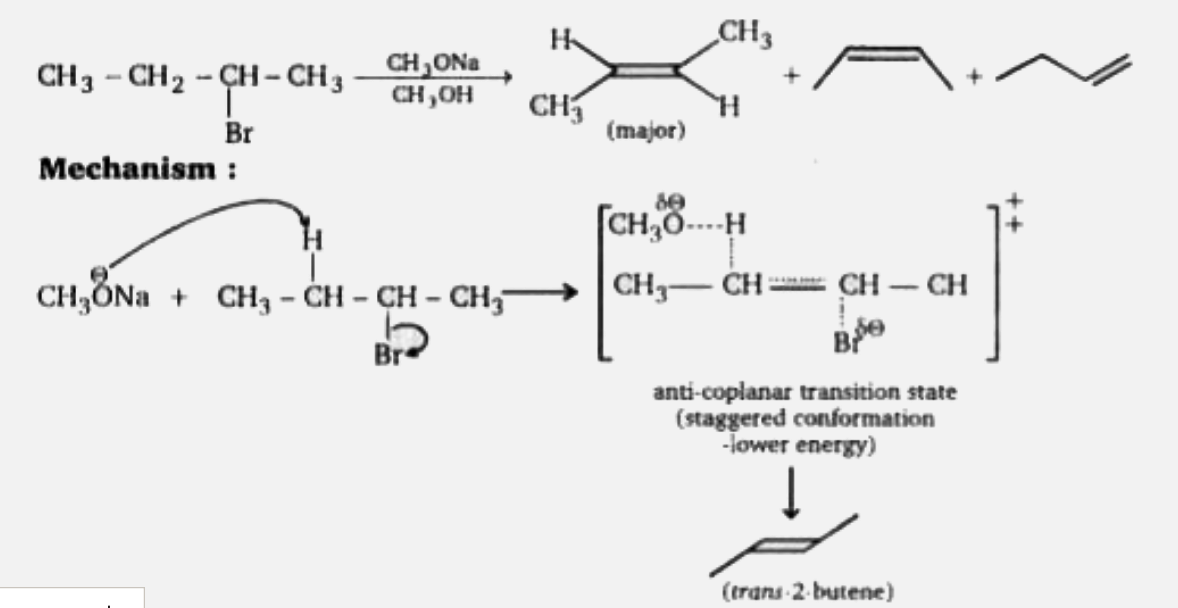Which of the following phrases are not correctly associated with SN1 reaction ?
(1) Rearrangement is possible
(2) Rate is affected by polarity of solvent
(3) The strength of the nucleophile is important in determining rate
(4) The reactivity series is tertiary > secondary > primary
(5) Proceeds with complete inversion of configurationSolution in Telugu
3,5
5 only
2, 3, 5
3 only
The correct Answer is:A
Informative question.
Topper's Solved these Questions
- ALKYL HALIDES (SUBSTITUTION REACTIONS)BOOK - MS CHOUHANCHAPTER - ALKYL HALIDES (SUBSTITUTION REACTIONS)EXERCISE - LEVEL-2
41 Videos
- ALKYL HALIDES (ELIMINATION REACTION) BOOK - MS CHOUHANCHAPTER - ALKYL HALIDES (ELIMINATION REACTION) EXERCISE - LEVEL-2
25 Videos
- AMINESBOOK - MS CHOUHANCHAPTER - AMINESEXERCISE - Level-2
1 Videos
Similar Questions
The order of the nucleophilicity of F−,Cl−,Br−andI− in protic solvents is
View SolutionComprehension
E2 raction → Elimination bimolecular
In the general mechanism of the E2 reaction a strong base abstract a proton on a carbon atom adjacent to the one of the leaving group. As the abstracts a proton , a double bond forms and the leaving group leaves.

Identify the rate ofreaction of given compounds in E2 reaction:

View SolutionFive amine syntheses are outlined below. In each reaction box enter a single letter designating the best reagent and conditions selected from the list at the bottom of the page.


View SolutionWhich of the following phreases are not correvlty associated with SN1 reaction ?
(I) Rearrangement is possible
(II) Rate si affected by polarity of solvent
(III) the strength of the nuclephile is important in determining rate
(IV) the reacityity series is tertiary gt secondary gt promany
(V) proceeds with complete inversion of configguation
View Solutionwhich is more reactive nucleophile in polar protic solvent ?
View SolutionWhich is more reactive nucleophile in polar aprotic solvent ?
View SolutionWhich of the following statement(s) is/are incorrect regarding SN1 reaction?
I) Rearrangement is possible.
II) Proceeds with complete inversion of configuration.
III) Rate depends on polarity of solvent.
IV) The strength of the nucleophile is important in rate determining step.
View SolutionWhich of the following statements are not correctly associated with SN1 reaction?
I. Rearrangement is possible.
II. Rate is affected by solvent polarity.
III. The strength of the nucleophile is important in rate determining step.
IV. The reactivity order is : tertiary > secondary> primary
V. Proceeds with complete inversion of configuration.
View Solutionwhich is more reactive nucleophile in polar protic solvent ?
View SolutionWhich is more reactive nucleophile in polar aprotic solvent ?
View SolutionWhich of the following statement(s) is/are incorrect regarding S_N 1 reaction? I) Rearrangement is possible. II) Proceeds with complete inversion of configuration. III) Rate depends on polarity of solvent. IV) The strength of the nucleophile is important in rate determining step.
View SolutionIn elimination reactions, the reactivity of alkyl halides is in decreasing order:
Tertiary > Secondary > Primary
Primary > Secondary > Tertiary
Secondary >Primary > Tertiary
None of These
View SolutionWhich of the following phrases are not correctly associated with Svi reaction ?
(1) Rearrangement is possible
(2) Rate is affected by polarity of solvent
(3) The strength of the nucleophile is important in determining rate
(4) The reactivity series is tertiary > secondary > primary
(5) Proceeds with complete inversion of configuration
View SolutionPrimary Secondary Tertiary alcohol#!#Acidic Strength of alcohol
View SolutionNucleophilic substitution reactions are of two types, substitution nucleophllic bimolecular (SN^2) and substitution nucleophilic unimolecular (SN^1) depending on molecules taking part in determining the rate of reaction. Reactivity of alkyl halide towards SN^1 and SN^2 reactions depends on various factors such as steric hindrance, stability of intermediate or transition state and polarity of solvent. SN^2 reaction mechanism is favoured mostly by primary alkyl halide then secondary and then tertiary. This order is reversed in case of SN^1 reactions. SN^1 reaction is fastest in
View SolutionNucleophilic substitution reactions are of two types, substitution nucleophllic bimolecular (SN^2) and substitution nucleophilic unimolecular (SN^1) depending on molecules taking part in determining the rate of reaction. Reactivity of alkyl halide towards SN^1 and SN^2 reactions depends on various factors such as steric hindrance, stability of intermediate or transition state and polarity of solvent. SN^2 reaction mechanism is favoured mostly by primary alkyl halide then secondary and then tertiary. This order is reversed in case of SN^1 reactions. SN^1 reaction is fastest in
View Solution
